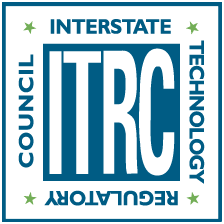Acknowledgments
The members of the Interstate Technology & Regulatory Council (ITRC) Sediment Cap Update Team wish to acknowledge the individuals, organizations, and agencies that contributed to this technical and regulatory guidance.
As part of the broader ITRC effort, the Sediment Cap Update Team effort is funded primarily by the U.S. Department of Energy. As part of the broader ITRC effort, the Sediment Cap Update Team is funded by the U.S. Department of Defense, U.S. Department of Energy, the U.S. Environmental Protection Agency, and ITRC’s Industry Affiliates Program.
The Sediment Cap Update Team appreciates the efforts of all team members who contributed to the development and completion of this document, as well as those who reviewed and provided comments on the document. The team also acknowledges the excellent support of ITRC staff.
The team leaders, Wesley Thomas (Oregon Department of Environmental Quality) and Richard Doucette (Virginia Department of Environmental Quality), along with the program advisers, Sonal Patil and Hilda Fadaei (Arcadis), wish to recognize the efforts of the following individuals who took on significant leadership and writing roles within the team:
- Ashley Lesser, Michigan Department of Environment, Great Lakes, and Energy
- Bhawana Sharma, Jacobs
- Danny Reible, Texas Tech University
- David Lampert, Illinois Institute of Technology
- Deirdre Reidy, Anchor QEA, LLC
- Edwin Barth, U.S. Environmental Protection Agency
- Erik Bakkom, Maul Foster & Alongi, Inc.
- Jennifer Maude, ITRC Public Stakeholder
- Kendrick Jaglal, CDM Smith
- Kim Groff, Ramboll
- Paul Schroeder, U.S. Army Engineer Research and Development Center
- Wardah Azhar, CDM Smith
The team would like to acknowledge the following state team members who shared their knowledge, input, time, and writing skills to prepare this guidance:
- Greg Neumann, New Jersey Department of Environmental Protection
- Iman Olguin-Lira, New Jersey Department of Environmental Protection
- John Cargill, Delaware Department of Natural Resources and Environmental Control
The team would like to acknowledge the following team members from the federal government who shared their knowledge, input, time, and writing skills to prepare this guidance:
- Amy Hawkins, NAVFAC Engineering and Expeditionary Warfare Center
- Carlos Ruiz, U.S. Army Engineer Research and Development Center
- Cindy Frickle, U.S. Environmental Protection Agency
- Paul Randall, U.S. Environmental Protection Agency
- Michelle Yam, NAVFAC Engineering and Expeditionary Warfare Center
The team would like to acknowledge the following industry team members who shared their knowledge, input, time, and writing skills to prepare this guidance:
- Adam Gutta, Brown and Caldwell
- Barbara Orchard Aragon, Arcadis
- Christina DeJarlais, Boulder Environmental Consulting, LLC
- Currie Mixon, GEI Consultants, Inc.
- Danielle Amber, Ramboll
- Derek Pelletier, ERM
- Edward Glaza, Parsons Corporation
- Heather Govenor, EnSafe, Inc.
- Jeff Hale, Kleinfelder
- John Collins, AquaBlok, Ltd.
- John Rice, TRC
- Katy Lindstrom, Barr Engineering Co.
- Kyle Apigian, Woodard & Curran
- Lauren Putnam, Arcadis
- Lisa Reyenga, GEI Consultants, Inc.
- Mark Surette, WSP USA Solutions, Inc.
- Michael Ellis, Barr Engineering Co.
- Michael Erickson, Arcadis
- Patrick Hsieh, Dalton, Olmsted, & Fuglevand
- Priscilla Viana, Arcadis
- Stacy Hopkins, ExxonMobil
- Tamara Sorell, Brown and Caldwell
- Timothy Sattler, Langan
- Todd Cridge, Haley and Aldrich
The team wishes to acknowledge the following team members who supported the creation of this guidance:
- Ben Wachholz, TRC Companies
- Carolyn Fusaro , Connecticut Department of Energy and Environmental Protection
- Carrie Webb, Wisconsin Department of Natural Resources
- Courtney Thomas, Geosyntec Consultants
- Jing Chen, Connecticut Department of Energy and Environmental Protection
- Madi Novak, U.S. Environmental Protection Agency
- Mellisa Powers-Taylor, Formerly Michigan Department of Environment, Great Lakes, and Energy
- Rob Webb, Dalton, Olmsted, & Fuglevand


